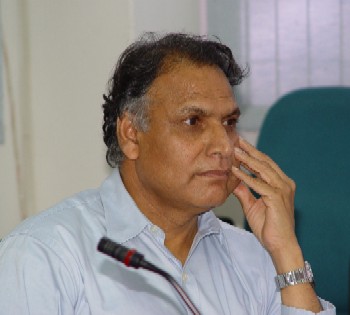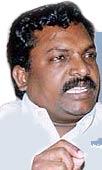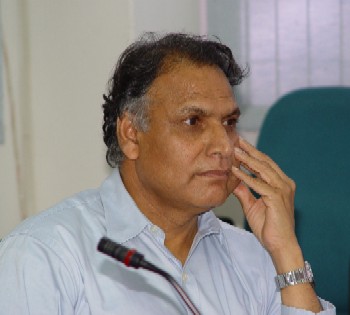(This interview was published in OneWorld South Asia in February 2010)
For inclusive growth, there is need for dual policy with share of benefit reaching to the poor and minorities, says Prof. Sukhadeo Thorat, Chairman, University Grants Commission, New Delhi. Breaking hierarchy and establishing a common public educational system with effective policy against discrimination will benefit everybody, he argues.
 In conversation with Anna Nath of OneWorld South Asia, Prof Sukhadeo Thorat points out that while social discrimination and exclusion still persist, there have been gains from policies such as reservation. There is more to be done, however, and education as a provider of opportunity, is a good place to start.
In conversation with Anna Nath of OneWorld South Asia, Prof Sukhadeo Thorat points out that while social discrimination and exclusion still persist, there have been gains from policies such as reservation. There is more to be done, however, and education as a provider of opportunity, is a good place to start.
OneWorld South Asia: Could you tell us about the pervasiveness of social exclusion in India, 60 years after it adopted its Constitution?
Prof. Thorat: In India we recognised the problem of social exclusion as early as the 1920s. In the 1930s, Dr.Bhimrao Ambedkar launched active movements against untouchability and discrimination, first in Maharashtra and then throughout the country.
So we recognise the problems of several social groups, including the Scheduled Castes (SC) who suffer the caste prejudices; Scheduled Tribes (ST); women and later on we also recognised the problems of OBC (Other Backward Caste); minority Muslims; and nomadic and denotified tribes. In fact we have a commission for each of these groups. We have set up committees to look at their problems. So it is well recognised that Indian society does suffer from the problem of social exclusion.
The constitution has made it obligatory that the States to adopt policies for economic and educational empowerment of ST, SC, OBC, women and we are beginning to take steps for the minors. So we do recognise and as a result of government policy there has been an improvement also. For example poverty declined over a period of time but the problem is that there are inequalities between this group and the rest of the society. For example if you take any indicator like poverty – in 2004-05, the poverty of ST is close to 40%, SC is 38% while in OBCs it is 30% or so, while in the case of others it is 15%.
You can see the disparity between certain groups that suffer from exclusion and the rest of the country. This is the situation with literacy rate, higher education and other indicators of women’s development including infant mortality. So the problem that exists today is that despite policy, progress all these social groups are not growing at the rate at which they ought to grow.
OWSA: Caste in our country, broadly speaking, also determines the class of our citizens. Do you agree with this formulation? If not, what should be the criteria for identifying citizens for positive discrimination?
Prof. Thorat: The answer is ‘yes’ and ‘no’. The point is that one has to recognise that the groups like SC, ST, OBC who suffer from caste discrimination also happen to be poor. Since they are denied access to economic rights, right to education as a result of they are poor. But in terms of solution poverty is not their only problem, which in fact is the problem of the high caste poor.
The high caste poor do not suffer from caste discrimination; whereas SC, ST and OBC while being poor, also suffer from discrimination – and this discrimination happens in regard to their civil rights, economic rights and political rights. So one cannot equate class with caste.
So for discriminated groups like SC, ST we require a dual policy. Education and economic empowerment is also required by all the poor, but for SC they require a safeguard against discrimination in the form of a reservation policy. So I think this distinction has to be drawn very clearly other wise there is a confusion that if caste is a class than why do you need a special policy, that is not the case. They suffer from economic deprivation, to that extent we can say that they are a poor class, but they are also a class that suffers from social deprivation.
OWSA: According to you, what has worked and not worked in the context of reservations over the last 60 years?
Prof. Thorat: There are people who argue that reservation policy has not worked, but this is not true. Reservation, in predominant forms, includes reservation in government employment, reservation in educational institutions, reservation in politics and other areas also, like reservation in public houses.
Now you take employment for example in public sector – reservation demands that the number of SC and ST in the sector should be in proportion to their population. In early 50s there was less number of SC, ST in government jobs; now you see that the quota in C and D categories is fulfilled. Even in A and B there has been an improvement, but the share is less than their population, so there needs to be much progress.
The other point that I would like to argue is – it is not true that reservation has not benefited the poor among the SC, ST. Of the total employment of SC and ST employed in central government 60% are in C and D. And what is C and D? They are class 3 and class 4 jobs. Who goes for class 3 and 4 jobs? It is the poor from the SC and ST. So reservation has also benefited the poor among the scheduled caste and schedule tribe and to that extent it has helped to remove their poverty.
Also I would like to mention that there is a social multiplier effect of reservation that if one person receives reservation in the family it will be extended to the relatives and extended family, as a result a help to one individual may reach to a group of individuals. So reservation has definitely helped for the social empowerment.
Education, for example you see in all the central universities and other universities there is reservation in the admission and there has been a progress there. In politics if there are MPs belonging to SC, ST then they play a very important role in the government decision making through the parliamentary committees. Whenever there is public housing, the SC, ST get houses. So it is not right to say that reservation has not helped. In my book ‘Dalit in India’ I have mentioned that reservation has helped.
There is no doubt about it and it has helped to build multiplier impact, it has also helped to reduce poverty. But the point is that there are several gaps.
There are certain areas where there representation is not fulfilled; there are several educational institutions where excluded groups are underrepresented. So those limitations have to be worked out in order to enable them to get the full advantage of reservation.
OWSA: It is very clear that mere social inclusion policy is not enough to address the issue of poverty and other kinds of deprivations. What more do you think is required to be done?
Prof. Thorat: The problem of SC and ST is a dual problem because of historical reasons. One that they do not a source of income, land and business, the other they have a problem of employment, the unemployment rate is high, the education rate is low. These are the things which are important for anybody to have income and have access to food, health, and housing. These are also the problems of the other poor.
But for scheduled castes the problem is additionally the discrimination that even if you give them the land and money for business they might face discrimination in acquiring the necessary services to start the business, they might face discrimination in the market. We might give them education and they become employable, and yet when they enter the market for job they might face discrimination. Even in school they might face discrimination.
So the schedule castes requires a dual policy. Land, income, housing business are required also by the other poor – those belonging to the non-discriminated group, but scheduled castes also require protection against discrimination in equal measure.
There are many sectors where the safeguards against discrimination are absent. There is discrimination in private sector employment. In a recent book published by Oxford, “Economic Discrimination in Modern India” we have shown there is discrimination against Dalits and Muslims in employment. (Economic Discrimination in Modern India, Sukhadeo Thorat & Katherine S. Newman, 2009)
Second example, in case of education we see students get admission in primary school in villages, however there is discrimination again within the school. Children eat separately in the mid-day meal scheme, have separate seating arrangements. Some studies have highlighted this. There is no policy about this although there are general guidelines.
Also discrimination in accessing health services in public heath sector – we don’t have a policy of safeguards in accessing public health. So these are the areas where we need to develop inclusive or anti- discriminatory policy or safeguard against discrimination to protect the rights of the minorities.
OWSA: There has been a lot of talk about creating a knowledge society by 2020. How do you see the participation of socially excluded groups in this process?
Prof. Thorat: You could look at two indicators for educational development – one is the literacy rate and the other in the sphere of higher education we can take the enrolment rate as an indicator of educational development. We find the literacy rate as well as the gross enrolment ratio in higher education lower in case of the SC, ST, OBC, Muslim, Dalit Muslim, Dalit Christian.
For example while the enrolment ratio in higher education is 10% or 11%, for ST it is 5% and for SC it is 6%; at the same time for women it is lower than for men, for Muslims it is lower than that of Hindus. Even within Muslims there are the Dalit Muslims, within Christians there are Dalit Christians. Enrolment rate for poor is only 2% in higher education as against a much higher figure for the non-poor. So we have to improve social conditions and provide educational opportunities.
OWSA: How do we do ensure equal educational opportunities overcoming social barriers?
Prof. Thorat: In India, we do have a strong public sector school system, and a strong public higher education system, but we need to strengthen and improve. We have to increase the number of state and central universities and equip them adequately. The number of central universities has now increased as a result of the special initiative of the present honourable Prime Minister Manmohan Singh.
The public educational systems at the level of school and higher education need to be strengthened and expanded. The other thing is that we have developed a lot of hierarchy in school system and colleges. For example, in the case of primary education, there are central schools for government employees, then Sainik schools for children of armed forces. This hierarchy in school education that we have created is only deepening inequality – that we give good education to some and less good education to others. This is not acceptable. We should have a strong common public education system that provides excellent and equal education to everybody.
In Europe the entire primary education is with public institutions and as a social need for everybody and education is therefore an equaliser, education reduces inequality by capacity building for everybody and everybody than makes use of it for economic growth.
In our society however education is becoming a source of inequality. Because those who get good education have better chance of getting employment. Education should be equaliser of opportunity. Same thing should happen in higher education as well.
Secondly, we have given a lot of stress to private education. Say higher education we have central and state universities that are run by government; then we also have state private universities, state central private universities or deemed universities, and there are several private self- financing institutions. in the private universities fees are too high so relatively poor students who are meritorious cannot get admission because they cannot afford it.
So for good education what we have to do is that while we have a good role for the private sector, we should see to it that the meritorious students are not denied equal education. So the private sector education has to be made inclusive by some policy.
So I think these policies are necessary, expansion of public sector education, universality in colleges and schools, second whatever role is given to private sector should incorporate policies that are tuned to provide opportunities to all and distribute resources in an equal manner to the poor through scholarships or other mechanism and government can also play important role in this.
[Courtesy: OneWorld South Asia, February 6, 2010]










